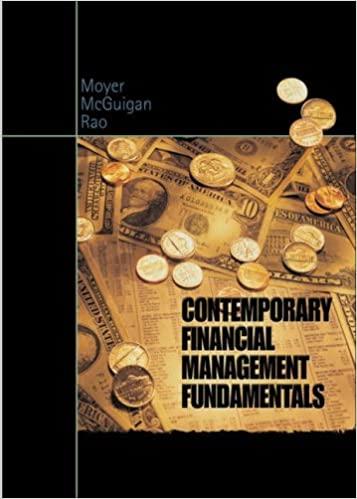Question
A firm currently offers credit terms of 2/10, n/30. You want to change the credit policy to 2/10, n/35. As a result of this change,
A firm currently offers credit terms of 2/10, n/30. You want to change the credit policy to 2/10, n/35. As a result of this change, sales are expected to rise by 15%; bad debts will rise from 1% to 3% of sales. All sales are credit sales.
Currently 30% of customers pay off their accounts in 10 days with 69% paying in 30 days and 1% paying in 100 days. The change will not affect the 30% paying early but is expected to increase the 1% late payers to 3%.
Assume: 365 day year
8% cost of capital
Operating expenses change as a percentage of sales
Taxes are at the 40% rate
Interest expense will drop by $1,000
| Income Statement Before credit change | |
| Sales | $200,000 |
| COGS | 120,000 |
| Gross Profit | 80,000 |
| Bad debts expense | 2,000 |
| Operating expenses
| 40,000 |
| EBIT | 38,000 |
| Interest expense
| 2,000 |
| EBT | 36,000 |
| Taxes | 14,400 |
| Net Profit
| $ 21,600 |
|
Before change
| Balance Sheet |
| Cash | $30,000 |
Accounts Receivable 13,534
Inventory 25,600
What is the amount of the new accounts receivable after the credit change?
- $16,447
- $15,564
- $16,000
- $18,954
A firm currently offers credit terms of 2/10, n/30. You want to change the credit policy to 2/10, n/35. As a result of this change, sales are expected to rise by 15%; bad debts will rise from 1% to 3% of sales. All sales are credit sales.
Currently, 30% of customers pay off their accounts in 10 days with 69% paying in 30 days and 1% paying in 100 days. The change will not affect the 30% paying early but is expected to increase the 1% late payers to 3%.
Assume: 365 day year
8% cost of capital
Operating expenses change as a percentage of sales
Taxes are at the 40% rate
Interest expense will drop by $1,000
| Income Statement Before credit change | |
| Sales | $200,000 |
| COGS | 120,000 |
| Gross Profit
| 80,000 |
| Bad debts expense | 2,000 |
| Operating expenses
| 40,000 |
| EBIT | 38,000 |
Interest expense 2,000
EBT 36,000
Taxes 14,400
Net Profit $ 21,600
Balance Sheet
Before change
Cash $30,000
Accounts Receivable 13,534
Inventory 25,600
What will cash be after the increase in sales if cash remains the same percent of sales?
- $30,000
- $33,700
- $34,000
- $34,500
Step by Step Solution
There are 3 Steps involved in it
Step: 1

Get Instant Access to Expert-Tailored Solutions
See step-by-step solutions with expert insights and AI powered tools for academic success
Step: 2

Step: 3

Ace Your Homework with AI
Get the answers you need in no time with our AI-driven, step-by-step assistance
Get Started


